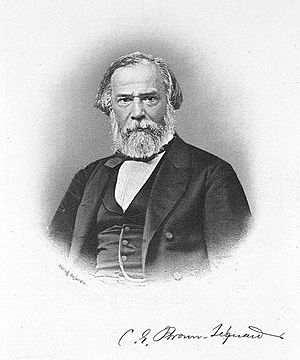Charles-Édouard Brown-Séquard facts for kids
Quick facts for kids
Charles-Édouard Brown-Séquard
|
|
|---|---|
 |
|
| Born | 8 April 1817 Port Louis, Mauritius
|
| Died | 2 April 1894 (aged 76) Sceaux, France
|
| Known for | Brown-Séquard syndrome |
| Scientific career | |
| Fields |
|
| Institutions | Virginia Commonwealth University |
Charles-Édouard Brown-Séquard (born April 8, 1817 – died April 2, 1894) was a famous scientist. He was a physiologist (someone who studies how living things work) and a neurologist (a doctor who studies the brain and nerves). In 1850, he was the first to describe a special condition. It is now called Brown-Séquard syndrome, named after him.
Contents
Who Was Charles Brown-Séquard?
Charles-Édouard Brown-Séquard was a very important scientist. He made many discoveries about how our bodies work. He especially focused on the nervous system, which includes the brain and spinal cord.
Early Life and Education
Charles-Édouard Brown-Séquard was born in Port Louis, Mauritius. His father was American, and his mother was French. He went to the Royal College in Mauritius. Later, he studied medicine in Paris, France. He finished his medical studies in 1846.
After his studies, he went back to Mauritius. He planned to work as a doctor there. But in 1852, he moved to the United States. He worked at the Medical College of Virginia. There, he did many important experiments. In 1854, he became a member of the American Philosophical Society. This is a group of smart people who study different subjects.
A Life of Travel and Discovery
Brown-Séquard traveled a lot during his life. He moved between Paris, London, and the United States. In 1859, he moved to London. He became a doctor at the National Hospital for the Paralysed and Epileptic. He gave many talks there. These talks were about how diseases affect the nervous system.
In 1864, he went back to America. He became a professor at Harvard University. He taught about how the body works and nerve diseases. He left Harvard in 1867. Then, he became a professor in Paris in 1869. In 1873, he returned to America again. He started practicing medicine in New York City.
Finally, in 1878, he went back to Paris for good. He took over a special position at the Collège de France. He stayed there until he passed away in 1894. He was buried in Paris.
Amazing Scientific Discoveries
Brown-Séquard was a very careful observer. He also loved doing experiments. He learned a lot about blood and how our bodies make heat. He also found many important facts about the nervous system.
He was the first scientist to truly understand the spinal cord. The spinal cord is like a highway for messages between your brain and body. He showed that pain and temperature signals cross over in the spinal cord itself.
His name is famous in medicine because of Brown-Séquard syndrome. This condition happens when one side of the spinal cord is injured. He described it after seeing farmers hurt their spinal cords. This happened while they were cutting sugar cane in Mauritius.
Even more important, he was one of the first to think about special substances. We now call these substances hormones. He believed they are released into the blood. Then, they travel to affect other parts of the body. This idea was a huge step forward in medicine!
Brown-Séquard wrote about 500 essays and papers. He wrote for the Archives de Physiologie. He helped start this important science journal in 1868. His research covered many different topics. These included how the body works and what causes diseases.
See also
- Brown-Séquard syndrome
- Hormone therapy

